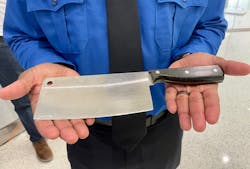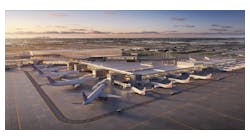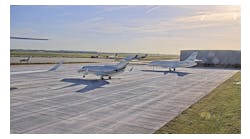TSA Officers Seeing Too Many Prohibited Items in Carry-On Bags at BWI Airport
The Transportation Security Administration (TSA) team at Baltimore/Washington-Thurgood Marshall International Airport (BWI) is coming across an abundance of prohibited items that travelers are bringing to the security checkpoints, which delays passengers from getting to their gates.
TSA has seen a return to near pre-pandemic passenger volume at BWI and one of the results has been an increase in the volume of prohibited items that travelers have tucked among their carry-on items.
One reason for the increase is that passengers who haven’t traveled recently are somewhat “rusty” in terms of remembering security checkpoint protocols, especially when it comes to remembering not to place prohibited items in a carry-on bag. “Travelers play an important role in ensuring a smooth and efficient security checkpoint screening experience,” said Christopher Murgia, TSA’s Federal Security Director for Maryland. “It starts with knowing what you should and should not pack in a carry-on bag.”
Advance planning and packing properly is key to a smooth security checkpoint experience. “We ask travelers do to their part by ensuring that they do not have any prohibited items with them at the checkpoint,” Murgia said. “Our TSA officers are seeing a lot of knives, brass knuckles, martial arts weapons and large tools, which can be used as bludgeoning instruments.
“We want people to ‘know before they go’ to the airport in terms of where to pack items,” Murgia explained. When packing for a trip there are three tried and true ways to find out where to pack an item. Unsure if an item should be packed in a carry-on bag, checked bag, either or neither? Download the free myTSA app, which has a handy “What can I bring?” feature that allows travelers to type in the item to find out if it can fly. This same feature is available on the TSA homepage.
The most common prohibited items that travelers bring to checkpoints are knives and tools larger than seven inches. Tools must be less than seven inches to be transported in carry-on bags. Knives also are all-too common at checkpoints.
“Unfortunately we see people bring all types of knives with them,” Murgia said. “We see Boy Scout knives, fishing knives, credit card knives, hunting knives, tactical fighting knives, chef’s knives, butter knives, keychain knives, folding knives, butterfly knives, switchblades, straight-edged knives, cleavers, knuckle-knives, cake knives, Swiss Army knives, souvenir knives, Leathermans, daggers and even machetes. These items should be packed in checked bags to be transported on a flight.”
When a TSA officer detects a prohibited item, the traveler is given the choice as to how they want to handle the situation. They can place the item in a checked bag, mail it to their home or to their destination, hand it off to a non-traveling companion, return it to their vehicle or voluntarily surrender it to TSA.
Other common prohibited items that TSA officers see with some regularity include pepper spray, inert grenades, ammunition, firearms (which are illegal on planes), axes, railroad spikes, throwing stars, stun guns, and fireworks/sparklers.





